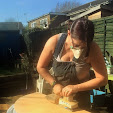This is a demonstration of something I told Graham Wegner yonks ago, when he was dissing his 'ordinary' home town of Adelaide, Australia. I pointed out that what to him is ordinary is most exotic to the rest of us. Well, the time has come for me to realise that this applies to me, too!
I have always been most scathing about the city in which I lived from the age of 10 until I left with a sigh of relief at 24. I once told my mother (who still lives there, along with most of my remaining family) that it was the *rse end of the earth, to which she retorted, "Well, it's a good thing you're just passing through, then!" Can you tell where I get my sense of humour from?
And then it came to light during a Twitter conversation today with Zoe Rose, aka Coelacanthro, that something that had formed such an integral part of the tapestry of my life was actually something very exciting and of global import.
Just off the coast of East London (that's a city on the east coast of South Africa, not a region in the capital of England), in 1938, a coelacanth was caught. So what, you might say. So what, indeed! This was a fish with 'legs' that had been thought extinct for some time. It was hailed as a living dinosaur, although it actually predates dinosaurs by several million years.
The woman who made the discovery, in amongst the catch of a local fisherman, was Marjorie Courtenay-Latimer, who was then the curator of the city's museum (let's not just skim over the realisation that this was a woman holding down a senior position before the second world war!). She didn't know what the fish was, just that it was almost certainly important. The find was confirmed by Prof. JLB Smith of Rhodes University, in Grahamstown. When I say it like that, it does no justice to Courtenay-Latimer's persistence. Smith was not an easy man to contact, or to engage, and several others had already told her that the fish was just a grouper.
However, once Smith was engaged, he was totally committed to the project of the 'living fossil'. When another coelacanth was caught off the Comores in 1953, he kept it in a box beside his bed all the way back home. It must have been a little niffy, to say the least!
The coelacanth still holds pride of place in the East London museum, as far as I know. I have seen it so often that it was only today that it dawned on me what a privilege it was to have such ease of access to such a unique specimen.
I once met Marjorie Latimer, albeit fleetingly, when she came to watch a show in which I was appearing in the local theatre. She was quite a feisty woman, considered something of a national treasure by the locals, who lived to the ripe old age of 97, dying in 2004.
Her life and mine had another rather odd overlap. When we visited East London in 2001, my mother gave me a rather large sum of money with the strict instructions that I was to spend it on a beautiful piece of jewellery (she becomes quite exasperated at my reluctance to spend money on myself). I went to a local jewellery designer, who was busy making repairs to a titanium coelacanth brooch he had made for Latimer's 90th birthday some years previously. He proudly showed it to me. Sadly, the coelacanth is not really a pretty fish, so it does not lend itself easily to design, but I'm sure that Latimer was tickled pink to have it, because of its significance in her life. And it must have proved successful, because the designer has gone on to create a whole range of coelacanth (and dolos - but that's another story) jewellery.
You can find a more complete account of the story here, and of course, wikipedia can tell you more about the dinofish itself. This site is also an excellent source of information and images for those interested in the topic.
Friday, April 17, 2009
LPoD - Marjorie Latimer and the coelacanth
Posted by
The upsycho
at
5:56 pm
![]()
Labels: environmental issues, LPOD
Subscribe to:
Post Comments (Atom)


No comments:
Post a Comment